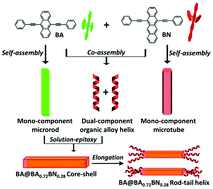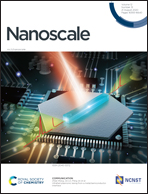A combination of an organic alloy and a heterojunction towards a rod–tail helix architecture with dual-color-emitting properties†
Abstract
An organic alloy can be regarded as a homogeneous solid solution wherein an isostructural molecule is randomly distributed in a host molecule, compared to an organic heterojunction where dissimilar materials generate an interface between two layers or regions. Herein, we fabricate an unprecedented novel BA@BA0.72BN0.28 heterostructure with a rod–tail helix configuration, in which the helical dual-component BA0.72BN0.28 alloy can be grown in a controllable manner onto the mono-component BA microrod, forming an organic core–shell micro-structure. In particular, the process of co-assembly formed could be described as the combined construction of an organic alloy and a heterojunction, and the co-assembly possesses the distinctive property of dual-color luminescence. This complex heterostructured architecture is achieved through a stepwise seed-induced growth method and the present solution-phase route allows us to construct more sophisticated organic luminescent heterostructured materials.

- This article is part of the themed collection: 2020 Nanoscale HOT Article Collection


 Please wait while we load your content...
Please wait while we load your content...